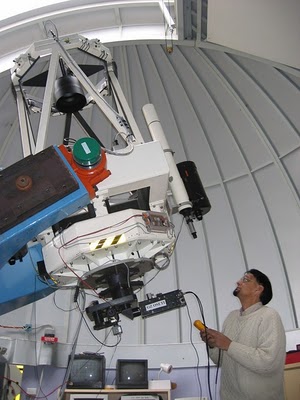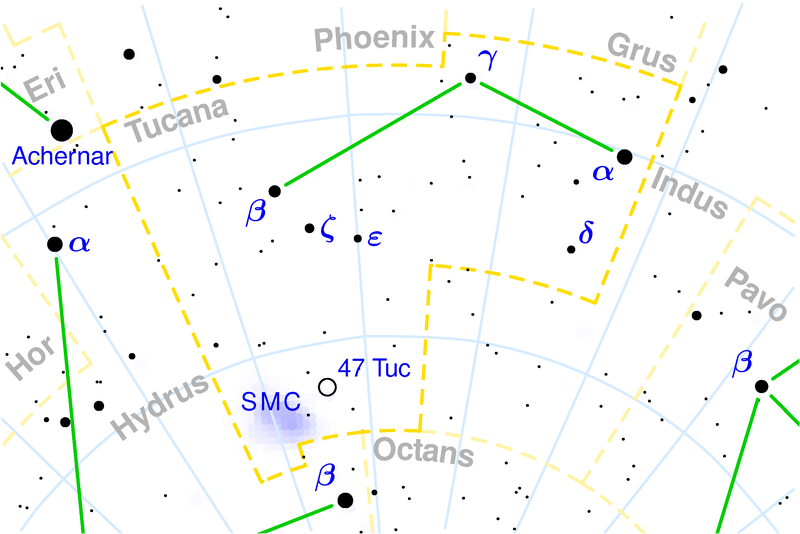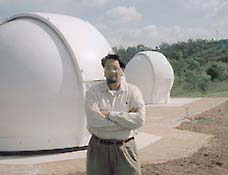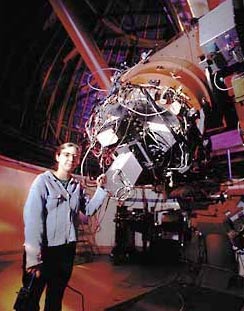|
|
||
|
..
Below is theOriginal Article that caused all the fuss.. The Australian released details of Dr Bhathal's discover on the same page as the discover of the extra solar planet Gliese 581e. Even though it clearly separates the two items, bloggers and other media continue to combine the two. Below the article I have a letter response from Dr Bhathal explaining that it was an error by the media.. Watch this space May 09, 2009
AFTER you've spent more than 20 years hunting for an alien signal, you think you'd be celebrating if you noticed a mysterious pulse suddenly rising up on your computer readouts. A regular pulse, amid the random clatter of the cosmos, suggests that someone very smart at the other end is sending a message. But when Ragbir Bhathal, an astrophysicist at the University of Western Sydney, who teaches the only university-based course on SETI (search for extraterrestrial intelligence) in Australia, detected the suspicious signal on a clear night last December, he knew better than to crack open the special bottle of champagne he has tucked away for the history-making occasion. Instead, he's spent the past few months meticulously investigating whether the unrecognised signature was caused by a glitch in his instrumentation, a rogue astrophysical phenomenon, or some unknown random noise. Even if he picks up the signal again - he's been scouring the same co-ordinates of the night sky on an almost daily basis since - the scientific rule book dictates he'll need to get it peer-reviewed before he can take his announcement to the world. "And that is a lot of ifs," he concedes. The hunt for extraterrestrial life has been boosted recently by the discovery last month of a rocky world not unlike our own, about 20 light years away, which its Swiss discoverers have dubbed Gliese 581e, the latest in a long line of planet discoveries during the past decade (350 and counting). Although Gliese 581e is too close to its host sun to support life, it's the first planet believed to be rocky like our own, a kind of super-hot Earth quite unlike the long line of gas and ice giants discovered to date. With the launch of NASA's Kepler space telescope in March, specifically designed to detect smaller Earth-like planets, astronomers are confident that the discovery of a blue planet, orbiting in the so-called Goldilocks zone, where liquid water can support life, is edging closer by the day. But it will still be up to ground-based telescopes to confirm the mass of the planet, as space-based telescopes such as the Kepler can only yield its approximate diameter. The quest of SETI astronomers, however, is not just for the discovery of an Earth-like planet but for life intelligent enough to transmit meaningful signals across vast stretches of space. For more than 40 years, they have been doggedly searching for alien transmissions via radio telescope, tracking tens of millions of radio signals across different sections of the night sky, but so far the results have been, by any scientific standard, dismal. There has been a handful of false alarms - the detection of short, intense bursts of electromagnetic energy that might be transmitted by an advanced civilisation - but these have been later shown to be caused by other cosmic phenomena, such as quasars. The belief that an alien civilisation might also be listening to our television and radio signals has also been dashed by the recent discovery that the signals don't, as once thought, reach into deep space: they eventually become so weak that they disappear in the roar of the electromagnetic noise. That is partly why the OZ OSETI (o for optical) project and a handful of its US counterparts have turned to laser pulse technology in what is the most ambitious effort yet to detect a signal from an alien species. "For an advanced civilisation, radio wave technology would be old hat," Bhathal says. "My strong feeling is that if there are (extraterrestrial intelligence) civilisations out there, they will send the signal by laser pulses or laser flashes." In 2000, science fiction writer Arthur C. Clarke, a former patron of the Australian SETI project, advised Bhathal to "let the better spectrum, light" drive his search for ET. Bhathal's OZ OSETI project is the only dedicated project for searching for ET in the optical spectrum in the southern hemisphere. "NASA is already using lasers for space communication and it's not unrealistic to imagine that an extraterrestrial intelligence might be using them as well," Bhathal says. "In terms of Earth technology today, we have achieved a maximum of 1015 watts of laser power for a brief period, butan advanced civilisation could have lasers with powers of 1025." He admits, however, that our failure to pick up any interstellar signals so far could mean that advanced civilisations are using a communications technique still not discovered on Earth. "It is risky to judge everything by our own technology," he says. The search field of the OZ OSETI project is 100 light years from Earth: a short walk around the block in galactic terms, but an area large enough to contain at least 1000 stars and possibly 20 times as many planets. While the discovery of worlds outside our solar system has given weight to the idea that the universe may be teeming with life - albeit sprinkled across an incomprehensibly wide area - it's the key cosmic numbers that have astronomers in disagreement. For example, how often do the magic ingredients for life - a rocky planet, located at just the right distance from its sun at justthe right moment in the sun's life - come together? If the answer is very often, there ought to be lots of planets like our own, and life may be more the rule than a miraculous accident. In 1960, Frank Drake, now a professor of astronomy at the University of Southern California, estimated that there could be up to a million technological civilisations in the Milky Way galaxy alone. But Bhathal believes "we are nowhere near being able to put a sensible figure on how common life may be". What we do know is that our sun is a perfectly ordinary star in a rotating island of 100 billion stars, the Milky Way galaxy, which in turn is just one of 100 billion or so galaxies in the observable universe. The laws of mathematics weigh heavily in favour of the idea that we are not alone. Moreover, the discovery of more than 300 planets suggests that solar systems such as ours may not be all that unusual. It's very likely that smaller and rockier worlds are more common than the gas giants, which are easier to find because of the greater wriggle they exert in a star's path. "The low-mass planets are much harder to find because they have a smaller Doppler amplitude," says Chris Tinney of the department of astrophysics at the University of NSW. "It might also mean we are not looking in the right way. But we're now certain that low-mass planets are more common. The Kepler space telescope will no doubt help usfind them." Tinney explains that while the basic techniques for detecting planets have been around for some time, what's revolutionised the field has been the dramatic technological improvements in spectrographs and telescopic power. "Planet searching has now become a sexy field and private donors in the US are putting money into it," Tinney says. Other satellite projects such as the Allen telescope array, named after Paul Allen, the Microsoft co-founder who donated $US13million towards its creation, are also coming online. The array uses an incredible 350 satellite dishes to scan the sky for the faintwhisper of radio signals from celestial objects such as quasars. There's also the hardware already in space if ET happens to be passing through our neighbourhood. The Pioneer 10 spacecraft, launched in 1972, included an aluminium plate with human figures, a drawing of the planets and an outline of the spacecraft's course. The last, extremely weak signal from this surprisingly robust spacecraft was received in 2006. If it's still around, Pioneer 10 would now be hurtling somewhere in the interstellar void outside our solar system. With the discovery of more planets, the relatively new science of exobiology, dedicated to the study of extraterrestrial life, has gained the gleam of scientific respectability. But the field is still trying to overcome the UFO stigma, laments Ain de Horta, a project scientist with the Australian SETI Institute. "There are still those in the scientific community who look down their noses at us, but that's increasingly unusual these days. There's a growing recognition that this is important science, with the potential to answer one of the most fundamental questions facing humanity. Those who lump us in with the UFO nuts tend not to be scientists," says de Horta. "We're counting on the physics being the same elsewhere in the universe." De Horta's institute is, in collaboration with CSIRO's Parkes telescope, scouring radio waves in its search for ET. "If an alien civilisation has developed technology it's likely to be based on most ofthe same principles as our own. Like us, forexample, they would have discovered radio waves." Even so, de Horta concedes, life elsewhere in the universe might resemble nothing we know on Earth. It could be moulded by different chemistries, different gravity and different climatic environments. In any case, it's highly unlikely we'll ever have a face-to-face meeting, as space travel even at Star Trek's warp drive wouldn't get us there in less than thousands of years. A two-way conversation would take decades. And even for that to happen, says de Horta, we would need intelligent life to be reaching its technological prime at the same time as ours and transmitting radio waves at a wavelength that we can detect. "The whole argument about communication hinges on the longevity of a species and their use of a technology that is recognisable to us," he says. What all the planet hunters and SETI have in common is a white-hot passion for discovering alien worlds. Bhathal knows that the odds of finding anything are long and the area he is scanning, as big as it is, may still not be extensive enough to yield anything, but he's determined to keep his eyes on the sky. "There (have) to be other Earth-like worlds. Otherwise what do we have? A whole lot of wasted space." SOURCE: The Australian |
||
|
..
Email from Dr Bhathal Hi Ron Thanks for your email. I think a couple of people from the European press made a mistake and associated my work with the work on extra-solar planets. I am carrying out a search for ETI in the optical spectrum. We are looking for laser pulse signals from outer space. The signal we detected came from the southern constellation Tucanae. Please find attached the signal for your use in your publications. We are still in the process of trying to figure out whether it is an ETI signal. Cheers. Ragbir |
||
|
..
Astrophysicist Ragbir Bhathal at the
University of
Western Sydney discovered a "suspicious" laser-like
signal coming from
the southern constellation Tucanae during a SETI
sweep. Bhathal is still
investigating the signal and scanning the
coordinates for a repeat detection.
Watch this space - The Australian - Report of Laser signal without the location given. This is the first report which caused othere to wrongly associate the signal with the other dicovery of Gliese 581E
|
||
|
...
To weed out
false 'hits,' an
optical SETI experiment needs to use at least two
detectors on the same
target simultaneously. Ragbir Bhathal at the
University of Western Sydney
in Australia has designed an optical SETI project
using separate 12- and
16-inch telescopes 20 meters apart. They watch
stars for nanosecond flashes
of light. Any such brief pulses from deep space
could only be artificial.
What would it take to send and receive a simple light signal? In answering this question, the STWG drew inspiration from a high-powered laser at the Lawrence Livermore National Laboratory. This leviathan light source (intended for triggering nuclear fusion rather than communicating with aliens) produces pulses that are a trillionth of a second long, brief indeed. But during that short pulse, the laser puts out a million billion watts. Note that the electric bill for this formidable flasher needn't be large. When pulsing once per second, its average power output is a measly kilowatt. Ragbir Bhathal and domes To weed out false 'hits,' an optical
SETI experiment
needs to use at least two detectors on the same
target simultaneously.
Ragbir Bhathal at the University of Western Sydney
in Australia has designed
an optical SETI project using separate 12- and
16-inch telescopes 20 meters
apart. They watch stars for nanosecond flashes of
light. Any such brief
pulses from deep space could only be artificial.
We could see a pulsed laser signal this bright beamed by a large telescope a few dozen light-years away, and a bigger brother could be used for communicating across a sizable chunk of the galaxy. For example, imagine a device 1,000 times more powerful than the Livermore laser affixed to a 10-meter telescope. If it packed infrared pulses into a billionth of a second, it would flash 25 photons per pulse into another 10-meter telescope 10,000 light-years away. Such a heavy-duty communication device could reach billions of stars! Even this little handful of photons, bunched into a single nanosecond, would stand out as artificial were anyone looking for it. Nature just doesn't do things like that. Of course, flashing a billion stars would be a major effort. But even a modest device could be useful for hailing to the stellar neighborhood. Imagine an automated beacon consisting of a laser ten or a hundred times heftier than the Livermore model feeding a computer-steered mirror system. This system might be tasked with sequentially "pinging" a thousand, or even a million, of the most promising stars. Assuming the system is supple enough to take aim in a tenth of a second, it could repeat its pings every two minutes if a thousand stars were being flashed, and once a day if the targets numbered a million. For laser beacons, the aiming accuracy has to be very good. If we assume that a reasonable target size to include any inhabited planets has a diameter of 10 astronomical units (the size of Jupiter's orbit) centered on a star, the pointing accuracy needs to be 0.03 arcsecond at 1,000 light-years. So the alien broadcasters will have to loft their laser beacons into orbit, where the atmosphere of their planet won't mess up the beams. In addition, they'll need to know the precise distance and motion of each star they're trying to ping in order to "lead" their targets by the right amount. But such aiming and tracking requirements are neither difficult nor particularly onerous. The aliens could do it. Suppose they have. Suppose such pulsed laser beacons exist? Shouldn't we look for them?
Shelley
Wright, a student at
the University of California, Santa Cruz, helped
build a detector that
divides the light beam from a telescope into three
parts, rather than just
two, and sends it to three photomultiplier tubes.
This arrangement greatly
reduces the number of false alarms; very rarely
will instrumental noise
trigger all three detectors at once. The
three-tube detector is in the
white box attached here to the back of the 1-meter
Nickel Telescope at
Lick Observatory.
Some people have. Stuart Kingsley in Columbus, Ohio, was busy pioneering optical searches for a decade, using a backyard 10-inch telescope and high-speed photomultipliers to look for pulses. A few years ago Paul Horowitz of Harvard and Dan Werthimer at Berkeley entered the optical SETI fray after participating in the STWG. They've geared up clever searches that "piggyback" on two medium-size telescopes that were already engaged in other stellar research. Starlight collected by the telescopes that would otherwise be wasted is sent through a beamsplitter and fed to a pair of photomultiplier tubes; a coincidence detector looks for very short flashes appearing simultaneously in each tube. (The use of two detectors is essential to reduce false alarms caused by cosmic rays, scintillation, and radioactive decays in the photomultipliers' glass itself.) Such detectors are simple and cheap. Amateurs can fit them to their scopes. Optical SETI is gaining adherents. Part of the appeal is that the telescope doesn't have to make good images. Paul Horowitz is building a 72-inch (1.8-meter) optical SETI telescope around a cheap "light bucket" of a mirror. The light will go through a beamsplitter to two arrays of 1,024 pulse detectors, each with nanosecond speed, covering a 1.6-by-0.2-degree rectangle of sky. Only recently have such arrays become available. This instrument, says Horowitz, will be able to examine every point on more than half the celestial sphere (not just selected stars) for at least 48 seconds every 200 clear nights ó roughly once a year, considering the weather. It will sweep the whole sky from declination +60 degrees to ≠20 degrees, a region that includes more than half the visible Milky Way. [It's up and running as of spring 2006; see our article.]. One followup to the STWG's work is the development of an improved detector for targeted optical SETI. Remington Stone of Lick Observatory has teamed up with Frank Drake (SETI Institute), Shelley Wright (University of California, Santa Cruz), Richard Treffers, and Dan Werthimer to build a device that should help keep observers' blood pressure low. It does so by reducing the number of false alarms. In a two-detector system, noise and electronic glitches still typically produce one false alarm per night, complicating the search. By using three photomultiplier tubes instead of two, the new experiment should only have about one false alarm per year. The new instrument is already checking out stars using Lick Observatory's 1-meter Nickel Telescope. "It's great," says Drake. "No terrestrial interference, such as complicates radio SETI. The only drawback is that you do require that the extraterrestrials are deliberately targeting you with their lasers." SOURCE: Sky and Telescope |
||
|
Dr. Ragbir
Bhathal latest 2010
interview which was conducted by VBS.TV Royce Akers
and Alex Dunbar.
Can you tell us the details surrounding your December findings? Oh OK, whenever thereís a clear night, I go up to the observatory and do a run on some of the celestial objects. Looking at one of these objects, we found this signal. And you know, I got really excited with it. So next I had to analyze it. We have special software to analysis these signals, because when you look at celestial objects through the equipment we have, you also pick up a lot of noise. Because theyíre very powerful? Yeah, thatís right. So the signal is inside the noise. What you have to do is use another program to extract that signal out of that noise. Well, after we did that, we found this very sharp signal, sort of a laser lookalike thing which is the sort of thing weíre looking foróa very sharp spike. And that is what we found. So that was the excitement about the whole thing. Great! So you discovered E.T.I. Well, the problem is with physics, to make a claim that you found something you have to then reproduce it again and again. That was the problem that stumped us. We went back to the same position and we still havenít found it. So what I did then was get all my data and I gave it to another chap who does what we call signal processing. You know, give it to someone else to take a fresh look at the whole thing and tell me whether there is a signal there or not. So he did that, and he came back and said that there is a signal there. Itís confirmed, there is a signal there. But the problem is, what is that signal, you see? And that is the problem we have now. We need to search some more space. And how exactly do you do that? Well, when you search for E.T, you automatically make a lot of assumptions. The chaps (the original S.E.T.I scientists) who were doing the radio wave technology believed that, if there were an E.T.I, then they would be sending signals on the radio wave. Well, theyíve been looking for that for the last 45 years now and nothingís appeared. Well, except for the one at University of Ohio. But again they found the signal but they never could get it back again. There was no repeat signal and therefore they could not figure out what it was. They looked in the same place again and again and they couldnít find it. I wrote a paper in an international journal that said look, if there are E.T. out there, they are probably much more advanced than us. And on planet Earth today, most of the telecommunications companies are going into fiber optics and lasers, you see. So I suggested that if these E.T.I. are more advanced than us, then they would send the signal to us not on the radio wave because radio wave technology would be old hat to them, they would be sending messages on laser beams, you see. Like beacons? Yes. And the reason I say this is when you look at the theory, a laser flash from a distant planet will outshine the light from itís own sun by about 5 or 7 orders of magnitude, depending on the type of laser they are using. So that was my idea. And on planet Earth itself, we can produce 1014 or 1012 watts of laser power, but only for a short time. So my calculation is, if there is an E.T.I. out there, they should be able to do 1025 or 1020 watts. Then it will work, you see. We have equipment which is sensitive enough to detect a laser flash from these guys if they actually send one to us. So itís pretty simple then? The only problem is, will they send it every day, will they send it every month, or whateverÖ and that is the problem. We donít know what the time frame is. And thatís the reason why you just have to keep looking at it. It seems ridiculous, but what do you do? If you donít search, you donít find. Source: http://www.vbs.tv/blog/ragbir-bhathal-aussie-alien-hunter Note: This link is currently dead |
||
| FAIR USE NOTICE: This page contains copyrighted material the use of which has not been specifically authorized by the copyright owner. Pegasus Research Consortium distributes this material without profit to those who have expressed a prior interest in receiving the included information for research and educational purposes. We believe this constitutes a fair use of any such copyrighted material as provided for in 17 U.S.C ß 107. If you wish to use copyrighted material from this site for purposes of your own that go beyond fair use, you must obtain permission from the copyright owner. | ||
|
|






